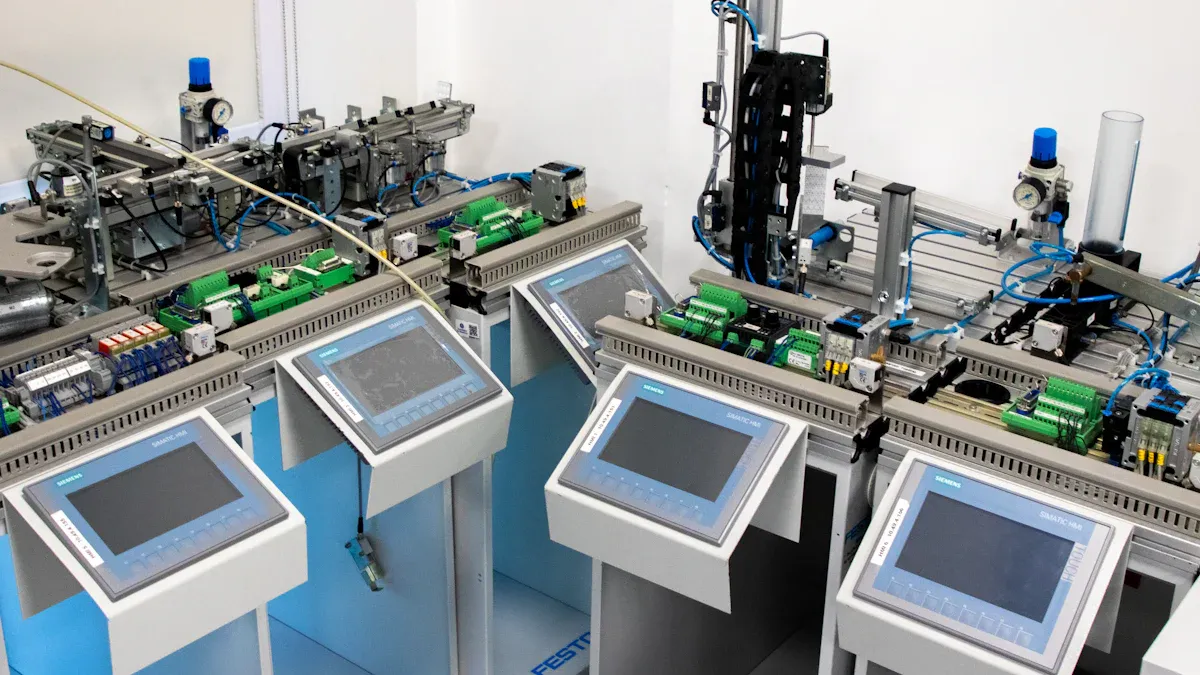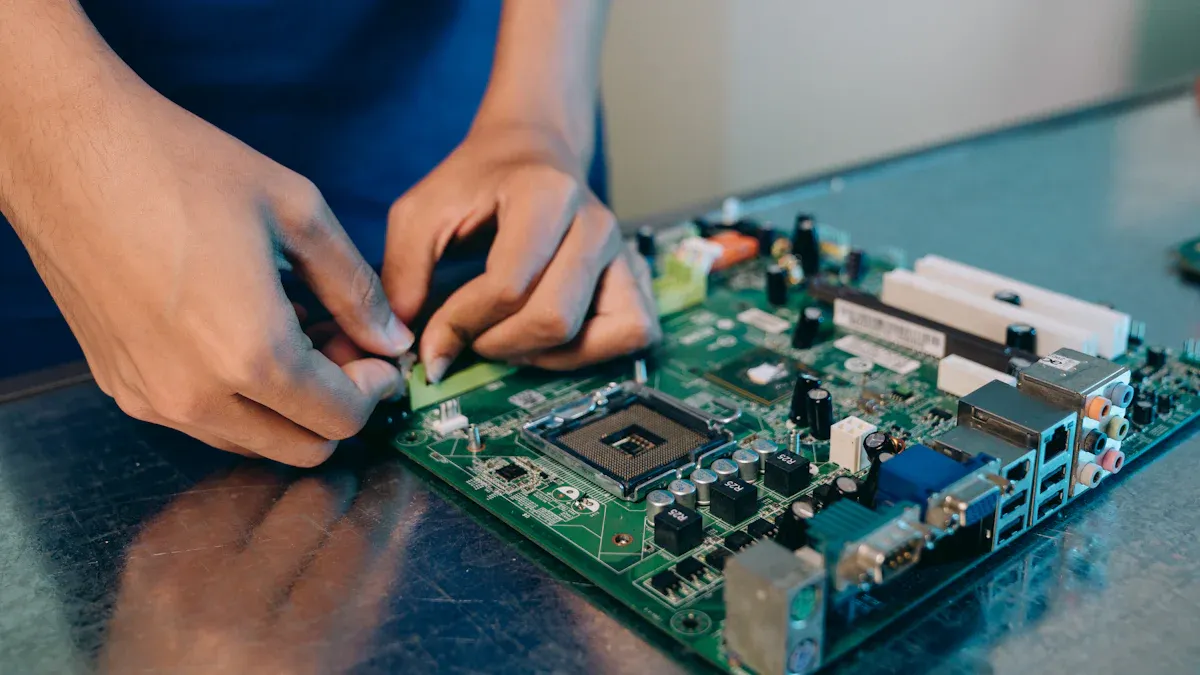How Advanced Turnkey PCBA Factories Ensure Quality Production

Modern turnkey PCBA factories are transforming the way electronics are manufactured. They integrate design, building, and testing into one seamless process. The electronics manufacturing industry is valued at nearly $800 billion globally. Modern turnkey PCBA solutions enhance production speed and reliability, ensuring products are delivered on time with first-pass success rates reaching as high as 98%.
Key Takeaways
Today’s turnkey PCBA factories handle design, assembly, and testing together. This saves time and cuts costs.
Machines and smart tools like AI and robots work faster. They make fewer mistakes, so products are better.
Picking a certified PCBA factory means safe and good products. This helps customers trust your brand.
Overview of Modern Turnkey PCBA Manufacturing
What Is Modern Turnkey PCBA Manufacturing?
Modern turnkey PCBA manufacturing is a simple way to make circuit boards. It combines all steps—design, making the board, getting parts, putting them together, and testing—into one process. Instead of using many companies, you work with just one. This saves time, lowers costs, and keeps quality steady.
What makes modern turnkey PCBA special is its use of advanced tools like surface mount technology (SMT) and automation. These tools help fit more parts on boards, work faster, and be more precise. Unlike older methods that are slower and need more hands-on work, turnkey solutions use fast prototyping and live monitoring. This makes them great for industries needing speed and accuracy.
Feature | Modern Turnkey PCBA Manufacturing | Traditional Methods |
|---|---|---|
Automation | Lots of automation | Mostly manual work |
Quality Control | Uses AI and machines | Checked by hand |
Prototyping | Fast prototyping | Slower prototyping |
Benefits of Turnkey Solutions for Quality Assurance
Turnkey solutions are great for keeping quality high. They handle every step, so there’s less chance of mistakes or miscommunication. This method keeps standards the same and checks quality at every stage.
For example, turnkey providers use tools like automated optical inspections (AOI) and statistical process control (SPC) to find problems early. They also follow lean manufacturing rules to cut waste and work efficiently. These steps improve quality, save money, and speed up production.
Benefit | Description |
|---|---|
One company handles everything, keeping quality the same. | |
Reduced Risk of Errors and Defects | Fewer vendors mean fewer chances for mistakes. |
Comprehensive Testing | Many tests are done during production to catch problems early. |
LTPCBA’s Role in Modern Turnkey PCBA
LTPCBA is a top company in modern turnkey PCBA manufacturing. Based in Shenzhen, China, they use advanced tools and focus on customers. Whether you need a prototype or large production, LTPCBA delivers high-quality results with their SMT assembly, automated systems, and strict quality checks.
Their quality is proven with a 99.5% success rate for deliveries. LTPCBA follows global rules like ISO, IATF, and UL, so you know they meet standards. They also offer live factory tours and regular vendor reviews to ensure top performance. With fast responses and 24-hour support, LTPCBA is a dependable partner for PCBA needs.
Evidence Type | Description |
|---|---|
Program Management | Skilled experts with 20+ years manage projects and ensure clear communication. |
Resident Engineers and Inspectors | Onsite staff reduce mistakes and ensure high-quality products. |
If you need a reliable partner for turnkey PCBA, LTPCBA has the skills and technology to help you succeed.
Key Processes in Quality Production

Design and Engineering
Design and engineering are the starting points for making quality products in Modern Turnkey PCBA manufacturing. The focus is on building reliable assemblies that work well. Engineers use ideas like Design for Quality (DFQ) and Design for Cost (DFC) to make sure the product works properly and stays within budget.
Rules like IPC-6012 and IPC-A-600 help pick materials and guide production steps. These rules keep quality steady during manufacturing. For instance, IPC-6012 helps choose strong materials, while IPC-A-600 sets rules for checking quality during production.
Engineers also use data from Statistical Process Control (SPC) to work smarter. This data shows patterns and helps improve processes, making production faster and better. Clear rules for what’s acceptable reduce mistakes and keep quality high.
Tip: Use clear numbers and facts to check quality. This makes sure your product meets measurable goals.
Prototyping and Validation
Prototyping and validation are important steps in Modern Turnkey PCBA manufacturing. At the start, the design is reviewed to find problems early. This saves both time and money. Engineers work with you to pick the best materials and parts, making sure the prototype matches the design plan.
New technology helps make prototypes quickly and accurately, even for tricky designs. Careful tests, like Automated Optical Inspection (AOI) and In-Circuit Testing (ICT), check if the prototype works well and is reliable.
Here’s how the process works:
Review the design to find problems early.
Pick materials that fit the design.
Make prototypes using advanced tools.
Test prototypes to check reliability.
Fix designs based on test results.
Share detailed reports to prepare for full production.
This process avoids delays caused by design mistakes and makes production smoother.
Manufacturing and Assembly
Manufacturing and assembly are where ideas turn into real products. Modern Turnkey PCBA factories use machines to work faster and more accurately. Steps like SMT first-article inspection and Automated Optical Inspection (AOI) catch problems early. This reduces waste and makes products more reliable.
Here are some key quality checks:
Quality Check | What It Does |
|---|---|
SMT first-article inspection | Checks the first batch of surface-mounted parts. |
Automated Optical Inspection (AOI) | Uses machines to find errors in circuit boards. |
X-ray solder joint analysis | Looks at solder joints for hidden problems using X-rays. |
In-Circuit Testing (ICT) | Tests each part on the board to ensure it works. |
Functional Testing (FCT) | Checks the whole product to see if it meets customer needs. |
Using advanced testing tools and smart methods improves product quality and builds trust with customers.
Testing and Quality Control
Testing and quality control make sure the final product meets industry rules. Modern Turnkey PCBA factories use many tests to check how strong and reliable the circuit boards are.
Some common tests include:
In-Circuit Testing (ICT): Finds shorts, open circuits, and faulty parts using special tools.
Flying Probe Testing: Great for prototypes, this test doesn’t need custom tools.
Functional Testing: Tests the product in real-world conditions to ensure it works as planned.
Environmental Stress Screening: Uses temperature changes and other tests to find weak spots.
Reliability Testing: Checks how well the product works over time in different conditions.
These tests catch bad boards early, saving time and money. They also give confidence that your products will work perfectly from the start.
Strong quality control builds trust and helps deliver dependable, high-quality products.
Advanced Technologies and Practices in Turnkey PCBA
Automation in PCBA Manufacturing
Automation is changing how circuit boards are made. It makes production faster, reduces mistakes, and keeps quality steady. In Modern Turnkey PCBA, automation is key to making reliable products. Factories now use smart tools like robots, IoT, and AI to handle tough jobs with accuracy.
Here’s a simple look at some automation tools:
Technology Type | What It Does |
|---|---|
Helps factories make quick, smart decisions during production. | |
Intelligent Sensors | Gathers data to track progress and improve how things work. |
Robotics | Handles repetitive tasks, cutting down on errors and saving time. |
Decentralized Systems | Adjusts quickly to changes, keeping everything running smoothly. |
Automation also lets factories watch their work in real time. For example, they can check energy use and production instantly. This saves money and helps meet eco-friendly goals. Plus, automated systems allow for custom products without slowing things down.
Did you know? Automated Optical Inspection (AOI) finds defects faster than people can. It ensures every product is high quality.
Quality Control Systems and Standards
Quality control is super important in making good circuit boards. In turnkey factories, it ensures every product meets strict rules. Advanced tools like Statistical Process Control (SPC) and AOI catch problems early.
Here are some important quality standards:
Standard | What It Checks |
|---|---|
Looks for issues like bad soldering or loose connections. | |
ISO9001:2015 | Makes sure all steps in production follow proper processes. |
Factories also do regular checks to keep these standards. This ensures your products are dependable and meet customer needs. Certifications like CE, FCC, and RoHS prove the factory follows high-quality practices.
Pro Tip: Always ask if your PCBA factory follows global standards. It’s an easy way to ensure great quality.
Industry Certifications and Compliance
Certifications show that a factory makes safe and reliable products. In PCBA, certifications like ISO and UL prove the factory cares about quality. For example, ISO 9001 focuses on managing quality, while RoHS ensures eco-friendly production.
Here’s a list of key certifications:
Certification | What It Proves |
|---|---|
ISO 9001 | Shows the factory focuses on quality and customer happiness. |
ISO 14001 | Confirms the factory uses eco-friendly methods. |
RoHS | Limits harmful materials to protect the environment. |
CE Marking | Proves the product meets EU safety and environmental rules. |
UL Certification | Ensures the product is safe and works well, especially for cars and other critical uses. |
These certifications aren’t just for following rules. They also help customers trust the factory. Choosing a certified PCBA factory means you’re picking quality, safety, and care for the planet.
Fun Fact: Some certifications, like FDA 21 CFR Part 11, require factories to save production data for 30 years. This helps track and fix any issues later.
Modern Turnkey PCBA factories make production easier and ensure great quality. They use measures like First Pass Yield (FPY) and waste reduction to work efficiently. These factories test products under tough conditions and follow lean manufacturing rules. Advanced tools and strict standards help them deliver reliable results. This gives your business an advantage over competitors.
Metric | What It Means | How It Helps Production |
|---|---|---|
First Pass Yield (FPY) | Tracks how many products pass quality checks the first time. | High FPY lowers waste and saves money. |
Waste Reduction | Cuts down on wasted materials and fixes fewer mistakes. | Reduces costs and keeps customers happy. |
Competitive Advantage | Reliable production improves delivery speed and customer trust. | Makes the factory stand out in the market. |
Tip: Pick a turnkey factory to simplify production and get dependable, high-quality products.
FAQ
What is the main benefit of turnkey PCBA manufacturing?
Turnkey PCBA makes production easy by doing all steps in one place. It saves time, avoids mistakes, and keeps quality steady. A stress-free option! 🚀
How does LTPCBA deliver high-quality production?
LTPCBA uses smart tools like AOI and follows strict rules like ISO and UL. They also run many tests to find problems early.
Can turnkey PCBA handle small orders?
Yes! Turnkey PCBA works for prototypes, small orders, and big projects. It’s flexible to fit your needs.
Pro Tip: Begin with a prototype to check your design before making more.
See Also
Boosting Project Efficiency With Quick-Turn PCB Prototypes
Choosing the Right PCBA Supplier for Your Requirements
Understanding Full Turn-Key PCB Manufacturing and Assembly Services
All-Inclusive PCBA Services: From Manufacturing to Assembly Testing
